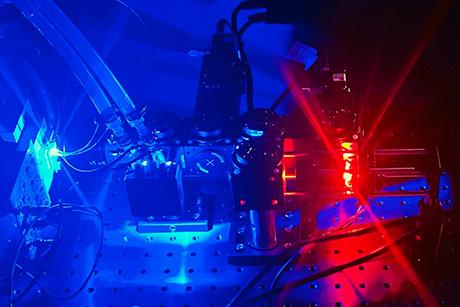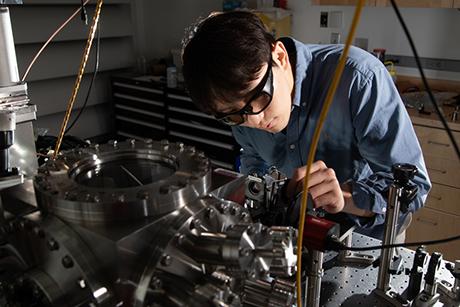Harnessing the speed of light
The fields of data communication, fabrication, and ultrasound imaging share a common challenge when it comes to improving speed and efficiency: light’s diffraction limit. Nicholas Fang thinks his group at MIT might have found a solution.
“In my group we play tricks with optics,” says Fang, an associate professor of mechanical engineering. These tricks have led to findings that allow for generating three-dimensional microstructures, using graphene as a more efficient delivery channel, and creating a new lens that would produce intense ultrasonic energy. With the ability to focus and target light onto the nanoscale, not only would data communication become quicker, but the diagnosis and treatment of disease would also become more precise, less invasive, less cumbersome, and more cost effective than current approaches.
Narrowing the target
One of Fang’s key discoveries is finding how to beat the diffraction of light. Since light and sound waves tend to spread out when blocked by an obstacle, images and communication signals can become blurry and muddled. In his lab, Fang discovered that by breaking the diffraction barrier, light signals can be sent at 10 times greater capacity. This has allowed him to produce results on the sub-nanometer scale, with light as a machining tool providing “a new degree of precision,” he says.
The benefits are two-fold: First, such technology could allow for printing electronic circuits using more manageable and less expensive equipment. Currently, to produce nanoscale features on computing chips, an extreme UV light source is needed. The investment costs can be in the hundreds of millions of dollars, Fang says. With new, high-resolution optics that can print nanoscale elements on the wafer scale, he says, costs can decrease to hundreds of thousands of dollars.
Second, the technology also provides the means to print and generate biosensors and scaffolding for tissue growth for artificial livers and artificial tumor models, among other things. When it comes to drug therapy, screening would become faster and delivery more precise, Fang says. The eventual goal, he says, is the creation of nanorobots and nanodevices that would can flow into the blood stream to detect malicious cells at an early stage and create a long-term, self-sustained care system.
A smarter optical fabric for chips
Fang says that he’s particularly excited about the potential to control and deliver a large bundle of light signals for communication over a small area. Increasing the downloading speed of data is nothing new — and is happening continually. But the ramifications of Fang’s work reach beyond downloading videos on a smartphone in under 30 seconds. The improvement means the same amount of data can be handled and exchanged across different chips, he says.
“Our vision is the cell phone will eventually be replaced by wearable devices,” says Fang, noting Pebble and Google Glass as current examples. This will help create a better user experience, through providing a more visual life that’s more transparent, portable, and energy efficient, he says.
The hope could lie in transmitting light on chips with graphene. Light itself is a marvelous carrier of information, Fang says, because it’s not limited by bandwidth, and signals don’t necessarily interfere with each other. The only problem is that the diffraction limit creates a bottleneck in which close signals can start bending towards each other. Think of a highway with everyone trying to exit at the same place at the same time. To prevent this kind of jamming with information, each signal needs to maintain its own identity.
This is where graphene comes in. The electronic benefits of the carbon-based material are already known, but the optical properties remain untapped. Graphene is 10 times faster optically than electronically and can guide light precisely, keeping signals in their own channel, in a sense, making light signals look more like motorcycles (smaller) rather than a big vans in traffic, Fang says. With light signals having a reduced size, more signals can be driven in the same field. “We could use graphene as our information highway,” he says.
One big question that remains is how much power is needed to drive each bit. But potential applications include implementation in Intel or IBM chips, increasing the amount of data capacity while decreasing the amount of response time to information. The end product? A smarter chip, Fang says.
Seeing cells through the body
For another project, Fang is applying his knowledge of optics to acoustics and ultrasound. Being able to generate intense ultrasonic energy would break up specific cells or cell membranes and inject them with drug particles. The challenge, once again, is the diffraction limit. Available medical devices can operate down to half a millimeter, but individual cells are micrometers. The need is to overcome 10 times the lens change in order to treat or cure one particular cell.
Fang says his research holds this possibility: He's shown the ability to generate a flat lens that can deliver acoustic energy into a tightly focused spot, meaning a healthy cell could be differentiated from a malignant one, and therapy could be targeted. A physician collaborator is still needed to build a suitable test that would gain eventual FDA approval, but Fang says he is excited about the potential. Compared to current methods, the device would be more precise — a large fiber bundle wouldn’t be needed to penetrate the body’s tissue — and would only need a fraction of the power. “We do consider this medical ultrasound innovation could be less invasive and it could be less painful for the patients,” he says.


